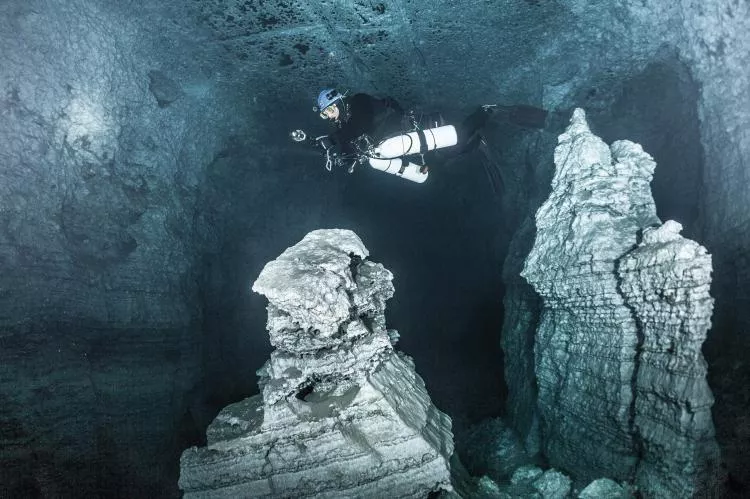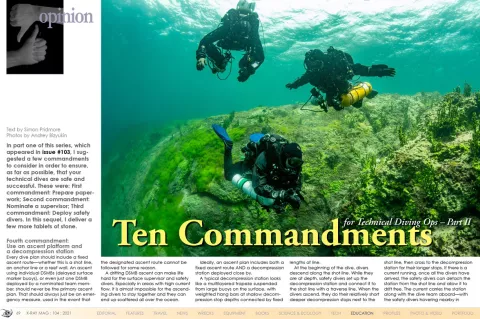In part one of this series, which appeared in issue #103, I suggested a few commandments to consider in order to ensure, as far as possible, that your technical dives are safe and successful. These were: First commandment: Prepare paperwork; Second commandment: Nominate a supervisor; Third commandment: Deploy safety divers. In this sequel, I deliver a few more tablets of stone.
Contributed by
Fourth commandment: Use an ascent platform and a decompression station
Every dive plan should include a fixed ascent route—whether this is a shot line, an anchor line or a reef wall. An ascent using individual DSMBs (delayed surface marker buoys), or even just one DSMB deployed by a nominated team member, should never be the primary ascent plan. That should always just be an emergency measure, used in the event that the designated ascent route cannot be followed for some reason.
A drifting DSMB ascent can make life hard for the surface supervisor and safety divers. Especially in areas with high current flow, it is almost impossible for the ascending divers to stay together and they can end up scattered all over the ocean.
Ideally, an ascent plan includes both a fixed ascent route AND a decompression station deployed close by.
A typical decompression station looks like a multilayered trapeze suspended from large buoys on the surface, with weighted hang bars at shallow decompression stop depths connected by fixed lengths of line.
At the beginning of the dive, divers descend along the shot line. While they are at depth, safety divers set up the decompression station and connect it to the shot line with a traverse line. When the divers ascend, they do their relatively short deeper decompression stops next to the shot line, then cross to the decompression station for their longer stops. If there is a current running, once all the divers have arrived, the safety divers can detach the station from the shot line and allow it to drift free. The current carries the station along with the dive team aboard—with the safety divers hovering nearby in attendance and the dive boat following.
A decompression station also provides a place to stage emergency equipment and spare decompression gas and, best of all, it keeps the whole dive team together.
Fifth commandment: Use helium and plenty of it
Deep dives go better with helium. Air is dense, so at depth it is difficult to breathe efficiently, and this can easily lead to carbon dioxide (CO2) build-up and hypercapnia. Air is also narcotic at depth and, below 60m (200ft), the oxygen content of air is high enough for it to become toxic and place a diver at risk of a convulsion. To make matters worse, CO2 build-up increases the likelihood of an oxygen toxicity convulsion.
The advantages of using air as the bottom gas for a deep dive are that it is available everywhere, it is easier and quicker to fill your cylinders with it, and it does not cost much. Especially if you are diving on open-circuit, using air rather than helium-based mixtures makes your diving a lot cheaper. Wherever you dive, helium is expensive.
However, the advantages of using helium outweigh the disadvantages enormously. Helium has been by far the most significant factor in making deep diving safer in the technical diving era. It is very light, non-toxic and only minimally narcotic. By including it in your breathing mixture to make trimix (helium, oxygen and nitrogen) or heliox (helium and oxygen), you considerably reduce the risks posed by narcosis, gas density and oxygen toxicity.
If you cannot afford to run a dive as safely as possible, using the optimum gas for each stage of the process, either change the plan or do not do the dive at all. Be aware that switching to air at highly narcotic depths can incapacitate any diver. Never use air as a travel gas. Stay on a helium-based mix until you get to a depth where you can safely switch to nitrox.
Sixth commandment: Do not take passengers
On any technical dive operation, there should be nobody in the dive team who is not fully trained to the level of the dive. It is always better to dive as a team, but if any member of that team is not capable of making the dive alone, AND able to go to the assistance of another team member in difficulty, then they should not be in the water. The strength of a dive team derives from it consisting only of independent, self-reliant divers functioning together.
Seventh commandment: Adopt a cave-diving mindset
Every diver on a technical dive must think like a cave diver. On a deep dive, you may be able to see the sun as you are on the way up, but you are often two or three hours of decompression away from feeling the sun directly on your skin. Once you have a decompression burden, you are in a “virtual” overhead environment. From a survival point of view, you might as well be in the darkness of a flooded cave, with solid rock above your head and far away from the nearest exit.
Among other things, thinking like a cave diver involves:
• Knowing and not exceeding your limitations
• Maintaining heightened levels of self-discipline and team discipline
• Remaining alert for events or situations that may increase the risk of the dive
• Being ready to abort the dive when any member of the team perceives a threat to the successful completion of the dive.
Eighth commandment: Never drop your guard
Never relax until you and your team are safely back on the boat or beach. Even if you think you have covered every eventuality, followed all the commandments and have all your procedures in place, this does not mean you can then take it easy at any point of the dive.
Anticipate that something unforeseen may happen and be ready to think on your feet. I have twice ascended from technical dives to find both the boat and the decompression station gone. Another time, I came up to find that the boat was still there, but all the safety divers were gone. And, on many occasions, dives that began in blue skies and flat, calm waters have ended three hours later in raging seas and driving rain.
Never make the mistake of seeing the primary goal of any dive as reaching a target depth, finding the end of a cave, or being the first person to lay eyes on a deep shipwreck.
The primary goal of EVERY dive is to return safe and well to the boat you jumped off or the beach you walked out from. That’s it. Only when you have accomplished that, can you relax, drop your guard and celebrate your achievement.
Ninth commandment: Dive as a team
When they first start technical diver training, students find confined water stress-testing drills impossible to manage, until they figure out that they have to deal with them as a team if they are going to confound the instructor’s best efforts to make them panic. Then the drills become quite straightforward.
This is a deliberate ploy, of course. By the end of the training, the students should be operating as a team independent of the instructor, whose role changes through the course from leader to observer. In technical diving, the team is always stronger than the sum of its parts. The team’s strength derives from its combined force, skills and gas supply.
Tenth commandment: Keep up to date
Generally speaking, the way we currently run and decompress from technical scuba dives works pretty well. But human knowledge of decompression science is still incomplete and imperfect. If you define perfection as diving protocols that are 100 percent safe, there is still much room for improvement.
The final commandment therefore is: Stay current. Stay informed and connected with the community, read the research papers that appear from time to time, attend technical diving conferences, monitor what others are doing and make sure your procedures still match the current science. If there seems to be debate and confusion, steer a conservative middle course until a scientific consensus is reached.
Finally, beware of outliers and prophets of a new way—especially if they are selling something. ■
Go to part one of this article in issue #103 here >>>
Simon Pridmore is the author of the international bestsellers Scuba Confidential: An Insider’s Guide to Becoming a Better Diver, Scuba Professional: Insights into Sport Diver Training & Operations and Scuba Fundamental: Start Diving the Right Way. He is also the co-author of the Diving & Snorkeling Guide to Bali and the Diving & Snorkeling Guide to Raja Ampat & Northeast Indonesia. His recently published books include The Diver Who Fell From The Sky, Dive into Taiwan, Scuba Exceptional: Become the Best Diver You Can Be, Scuba Physiological: Think You Know All About Scuba Medicine? Think Again! and the Dining with Divers series of cookbooks. For more information, see his website at: SimonPridmore.com.





























